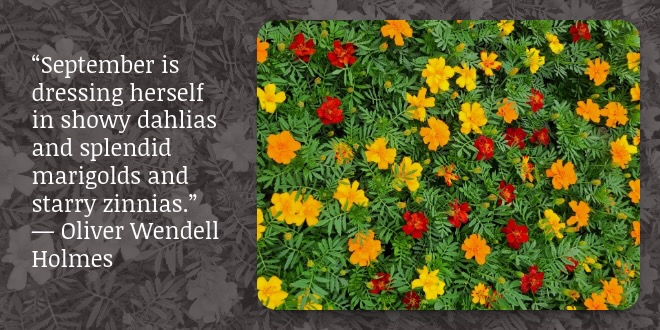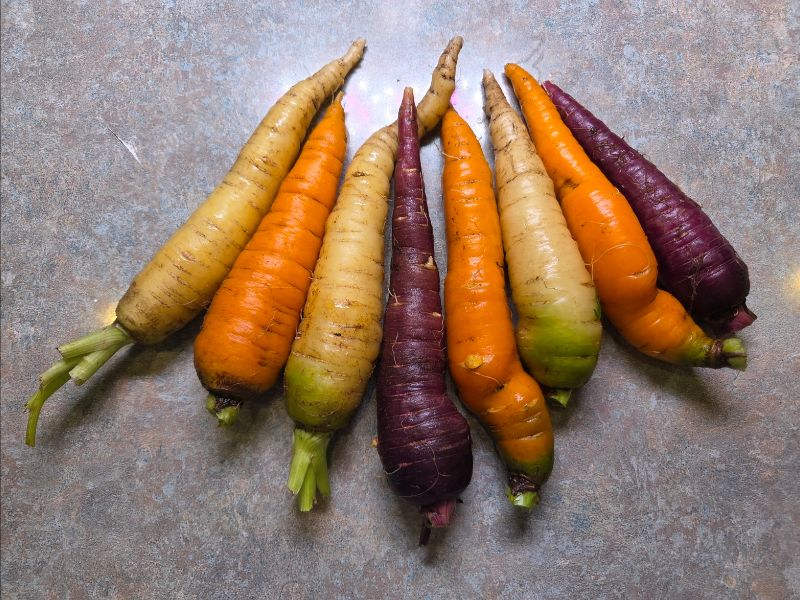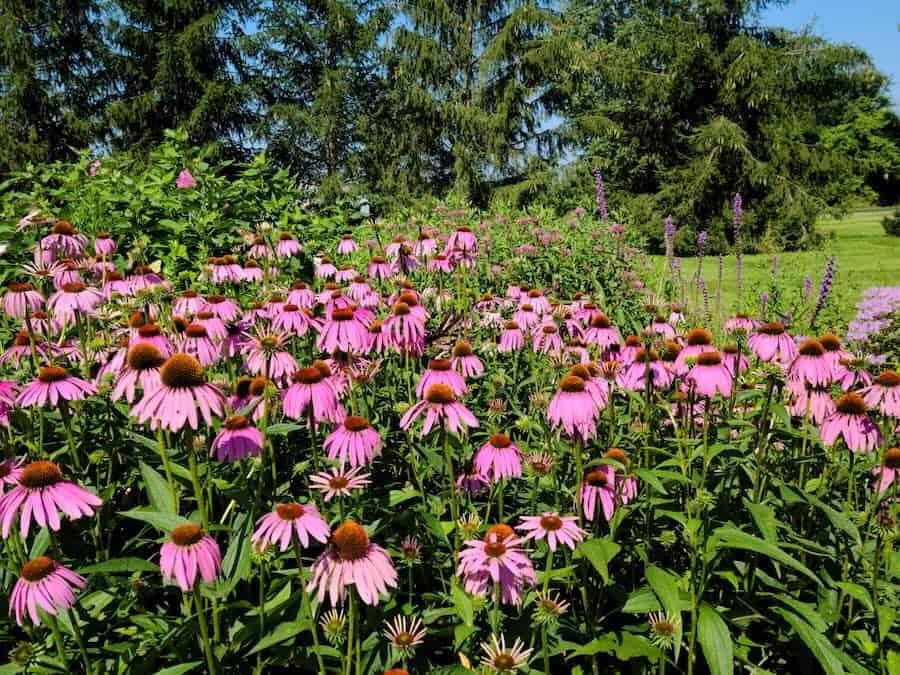
It seems that Mother Nature lost interest in summer about two-thirds of the way through the month of August this year. Maybe she just ran out of steam, which I could understand, considering how amazingly hot and humid it had been for so long. The cool-down has me a little conflicted though, because while I was loving not having my air conditioning running 24/7, I have about fifteen eggplant fruits on my plants that need a little more time in the heat to get big and ripen. Unfortunately, NOAA recently updated their outlook for the next two weeks, and it doesn’t look good for eggplant weather from the 4th through the 8th. They’re calling for highs in the 60’s and lows in the 40’s Thursday through Sunday. However, if they’re right, we’ll be back up into at least the mid-70’s for a little bit after that, so there’s hope for my eggplants yet.
Jennifer
This month’s issue of Let’s Get Gardening
Subscribe to our monthly newsletter for seasonal gardening advice and recommendations for your garden, yard, and bird feeding.
Even if the temps last week were more fall-like than normal, that doesn’t mean that gardening season is anywhere near finished. There’s still lots to do:
In the Veggie Garden:
- Plant leaf lettuces and radishes early in the month – there should still be plenty of time for those to produce yet this season, as many will come to maturity in under a month. Check the seed packet to be sure, though. If they take more than about 30 days, you may be pushing your luck to have them ready before frost starts showing up.
- Kale and some spinach can also still be planted, as they are a little hardier and can stand a little more of the cold temperatures that will likely hit before these plants are done producing, but put in plants, rather than seeds. Seeds likely won’t have enough time to mature before the cold sets in.
- Garlic is my favorite thing to plant in the fall, but don’t be in too much of a hurry. Garlic is best planted after the soil has cooled down enough to not encourage foliage growth, but still warm enough to allow roots to get established before the real cold weather sets in. That can usually be anywhere from early October to mid-December around Southeast Michigan. We don’t yet have an arrival date for our garlic bulbs this year, but I expect we will see them before the end of the month. I’ll send out a special email announcement when they do arrive – I know many of you are anxiously awaiting their arrival (as am I).
- Pinch off flowers on tomatoes, peppers, and eggplants. I did mine just yesterday, because all of them had lots of flowers still. Those flowers aren’t going to have enough time to reach maturity before cold weather sets in and removing them will help the plants put all their energy into ripening the fruits that are already on the plants. My peppers already have more fruits than I can possibly use anyway, and my tomatoes and eggplants aren’t slacking this year either!

- Continue harvesting things like carrots, peppers, beans, cucumbers, corn, and summer squashes until they are all done producing. Winter squashes may be ready for harvesting by the end of the month – they won’t do well once we start getting hard frosts, but don’t pick them before they are truly ready. If you planted late season cabbage and broccoli, they are likely going to be ready for picking late this month or early next month.
- Many herbs are also still going strong in September, but most will need to be harvested soon. It’s been a great year for basil at my house, and I’ve also still got lots of sage, parsley, rosemary, thyme, and dill. If you can’t use everything from your herb garden right away, freezing is the easiest way to preserve all but the basil. Wash the herbs, dry them thoroughly, and then chop them up. Place the chopped herbs into a “zipper” freezer bag, squeeze out every bit of air that you can, and then place them in the freezer.
- Basil doesn’t freeze well, so drying it (or making pesto) is the best way to have that for later use. If you are seeing black spots on your basil, it is likely because of the low nighttime temperatures we had last week. Temperatures below 50° F can cause tissue damage in basil, which is what those black spots are. To prolong the harvest of basil, cover it on nights when we’re expecting lower temps.
Flower Gardens, Trees & Shrubs, Lawn:
- If you have been fertilizing your perennials, shrubs, and trees this summer, stop now. Fertilizing encourages new growth, and new growth now will likely not have enough time to harden before the temperatures drop below freezing.
- This month is a great time for planting all kinds of things, besides the vegetables we’ve already talked about. Perennials, shrubs, and trees planted in the fall can get their roots established while the soil is still warm. We usually get pretty good precipitation in the fall, but keep an eye on the amount of rain you’re getting to make sure that your new plants get enough water to make it through the winter.

- This month and next are also a good time for dividing and transplanting lots of plants. I have a number of perennials in need of dividing in my yard. Fortunately, I also have lots of friends who are interested in some plants, so I’ll have help in digging them up and finding them new homes this fall. You can generally tell if it’s time to divide a plant by how it looks. Plants can look hollow at the center or be drooping around the edges. Plants that are producing fewer or smaller than usual flowers are also probably trying to tell you that they need more space.
- If you have tender summer bulbs, such as dahlias and calla lilies, wait until the foliage is dried up to dig them up for winter storage – but don’t wait until the ground is frozen. Depending on the weather, this task should be done late this month or early next.
- Spring bulbs, including crocus, daffodils, and tulips, get planted in the fall because they need to go through a chilling period in order to bloom in the spring. Like garlic bulbs, plant these flowering bulbs after we have had a few frosts, but before the ground is frozen. We’ll start getting our spring bulbs in at the store in mid-September, with others arriving by mid-October. Be sure to get your favorites early so you don’t miss out.
- Bring house plants back in that you put outside for the summer, but spray with pesticide before you do, so as not to bring unwanted guests in with them.
- Don’t prune trees and shrubs unless it’s to remove dead or damaged branches. Other pruning now can encourage new growth that will be susceptible to harm when cold weather sets in. The best time for pruning most trees is in deep winter – think February – when trees are dormant, and pruning doesn’t cause wounds that weep, which can attract disease-bearing insects.
- I’m seeing some trees in the area with leaves that are already turning yellow or brown and falling. This isn’t a sign of an early winter, but more likely a sign of stress suffered at some point. Some spots in our area – like my house – have not received a lot of rain this summer, which can stress trees just like it does other plants. Leaves are often the first sign of stress in trees, so don’t be surprised if you see early color changes and dropping. There are other potential problems that could be causing your particular trees to experience stress, such as being hit by a weed whip or mower, having an infestation of insects, or diseases that take advantage of high humidity like we had this summer. Take a close look at your trees to see if you can detect any issues that you might be able to do something about before you assume it’s just a lack of water.
- Water any new or young trees, and any that have been showing signs of stress, all the way up until the ground freezes. Trees can’t take up much moisture from the frozen ground during the winter, so they need to be well hydrated before then. Throughout the winter, if we get thaws, water your trees then, as well.
- Whenever leaves fall in your yard, be sure to rake them up to avoid problems in your lawn next year. You can shred them and compost them or save them to use as an extra layer of protection in the form of mulch for your planting beds once the ground has frozen. Rake them off in the spring, when the ground has warmed up, and then add them to your compost pile.
- As the weather cools off, it’s a great time to fill in bare spots in your lawn. To overseed your lawn’s bare patches, start by raking away any dead grass and roots, and then sprinkle some seed in. You can also add a little bit of topsoil to give the seed a better chance to take hold. Don’t forget to cover the area lightly with a little mulch (straw works well) to keep moisture in. Keep the area well watered. Once the grass starts to emerge, remove the mulch so as not to smother the grass.
- De-thatch your lawn, if necessary. This is something that most people don’t do, and probably should, if they want a really good-looking lawn. According to the MSU extension, “Thatch is the accumulation of dead and decomposing turf stems, leaves and roots intermixed with live plant roots.” It’s not due to leaving clippings on the lawn, which is good for it. MSU offers good information on how to de-thatch your lawn here.
- September is the time to fertilize your lawn – maybe. The right time to fertilize your lawn depends on many factors, including how you mow, whether you irrigate, and whether you bag the clippings or leave them on the lawn. The stage of your lawn is also important – is it a new lawn, or well-established?
For the Birds:
- September is for the birds, in many ways! Lots of birds are on the move this month, heading south for the winter. Some are coming from even farther north, stopping along the way for refueling. According to the Cornell Lab of Ornithology’s Birdcast Migration Dashboard, more than 6.6 million birds flew over Michigan the night of Saturday, August 30th. You can help them on their way by putting out feeders (if you haven’t been feeding them all summer) and keeping the feeders filled.
- That goes for hummingbirds, too. Keeping your nectar feeders clean and filled into October could help the late travelers make it to their winter homes. You might also be rewarded with a sighting of an unusual hummer. Some of the hummingbirds that don’t breed here in Michigan travel through on their way to and from their breeding grounds much farther north. They are coming from such far distances that they might not come through here until October, so if yours is the only feeder in sight, you just might catch a glimpse.
- Providing a clean source of water for those weary feathered travelers is also a great idea. Flying hundreds of miles is thirsty work! Keep your bird baths cleaned out and filled up for them.
Read More
More info on all of these tips can be found in our monthly newsletter: Read the full September 2025 issue of Let’s Get Gardening
Happy Gardening!
🌿 This September🌿
🌿 The Garden Mill’s First-Ever Concrete Statuary Sale! 🌿
For the first time ever, The Garden Mill is offering special savings on our beautiful collection of concrete statuary! From elegant bird baths and benches to charming animals and timeless garden accents, each piece is crafted to add beauty, character, and lasting quality to your outdoor spaces.
✨Made in Michigan!
✨ Durable. Artistic. Timeless.
✨Perfect for gardens, patios, and landscapes.
✨On sale September 1st through 30th.
Don’t miss this chance to bring home the perfect statement piece for your garden at a great price. Visit The Garden Mill today and discover unique designs that will make your outdoor space truly unforgettable. Shop online and pickup in-store, or come into the store for the biggest selection.
Sorry – we cannot ship concrete. Sale cannot be combined with other offers.

$10 off any $50 purchase

Expires 9/30/25
Cannot be combined with any other offer.
Not valid on artist consignment items.
Cannot be used to purchase gift certificates.
